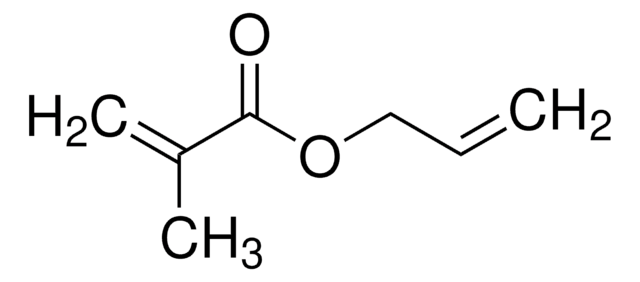Products may be shipped at a different temperature than the recommended long-term storage temperature. If the product quality is sensitive to short-term exposure to conditions other than the recommended long-term storage, it will be shipped on wet or dry-ice. If the product quality is NOT affected by short-term exposure to conditions other than the recommended long-term storage, it will be shipped at ambient temperature. As shipping routes are configured for minimum transit times, shipping at ambient temperature helps control shipping costs for our customers. For more information, please refer to the Storage and Transport Conditions document: https://www.sigmaaldrich.com/deepweb/assets/sigmaaldrich/marketing/global/documents/316/622/storage-transport-conditions-mk.pdf
335681
Dimetacrilato de etilenoglicol
98%, cross-linking reagent polymerization reactions, methacrylate, 90-110 ppm monomethyl ether hydroquinone as inhibitor
Sinônimo(s):
Dimetacrilato de 1,2-etanodiol, Dimetacrilato de etileno
About This Item
Produtos recomendados
Nome do produto
Dimetacrilato de etilenoglicol, 98%, contains 90-110 ppm monomethyl ether hydroquinone as inhibitor
densidade de vapor
>1 (vs air)
Nível de qualidade
pressão de vapor
<0.1 mmHg ( 21.1 °C)
Ensaio
98%
Formulário
liquid
contém
90-110 ppm monomethyl ether hydroquinone as inhibitor
adequação da reação
reagent type: cross-linking reagent
reaction type: Polymerization Reactions
índice de refração
n20/D 1.454 (lit.)
p.e.
98-100 °C/5 mmHg (lit.)
densidade
1.051 g/mL at 25 °C (lit.)
Ω-final
methacrylate
α-final
methacrylate
arquitetura do polímero
shape: linear
functionality: homobifunctional
temperatura de armazenamento
2-8°C
cadeia de caracteres SMILES
CC(=C)C(=O)OCCOC(=O)C(C)=C
InChI
1S/C10H14O4/c1-7(2)9(11)13-5-6-14-10(12)8(3)4/h1,3,5-6H2,2,4H3
chave InChI
STVZJERGLQHEKB-UHFFFAOYSA-N
Procurando produtos similares? Visita Guia de comparação de produtos
Descrição geral
Aplicação
- um sistema de terpolímero, poli(acrilonitrila-co-etilenoglicoldimetacrilato-co-cloreto de vinilbenzil), que é aplicável como um sorventena adsorção de produtos farmacêuticos.
- Hidrogel à base de PVA (álcool polivinílico) por copolimerizaçãode radical livre. Essas redes de polímeros PVA podem ser usadas como sistemas de distribuiçãode medicamentos.
Palavra indicadora
Warning
Frases de perigo
Declarações de precaução
Classificações de perigo
Skin Sens. 1 - STOT SE 3
Órgãos-alvo
Respiratory system
Código de classe de armazenamento
10 - Combustible liquids
Classe de risco de água (WGK)
WGK 1
Ponto de fulgor (°F)
219.2 °F - Pensky-Martens closed cup
Ponto de fulgor (°C)
104 °C - Pensky-Martens closed cup
Equipamento de proteção individual
Eyeshields, Faceshields, Gloves, type ABEK (EN14387) respirator filter
Escolha uma das versões mais recentes:
Já possui este produto?
Encontre a documentação dos produtos que você adquiriu recentemente na biblioteca de documentos.
Os clientes também visualizaram
Artigos
Monomers for ophthalmic use aim for purity, reliability, and comfort, driving innovation for affordable contact lenses.
-
How is shipping temperature determined? And how is it related to the product storage temperature?
1 answer-
Helpful?
-
-
How can I determine the shelf life / expiration / retest date of this product?
1 answer-
If this product has an expiration or retest date, it will be shown on the Certificate of Analysis (COA, CofA). If there is no retest or expiration date listed on the product's COA, we do not have suitable stability data to determine a shelf life. For these products, the only date on the COA will be the release date; a retest, expiration, or use-by-date will not be displayed.
For all products, we recommend handling per defined conditions as printed in our product literature and website product descriptions. We recommend that products should be routinely inspected by customers to ensure they perform as expected.
For products without retest or expiration dates, our standard warranty of 1 year from the date of shipment is applicable.
For more information, please refer to the Product Dating Information document: https://www.sigmaaldrich.com/deepweb/assets/sigmaaldrich/marketing/global/documents/449/386/product-dating-information-mk.pdfHelpful?
-
-
Is the ethylene glycol dimethacrylate a toxic crosslinker for human?
1 answer-
The toxicological information for product 335681 can be reviewed in the SDS.
See the link below, section 13, to review this information:
https://www.sigmaaldrich.com/sds/aldrich/335681There are articles available in the literature as well. See the link to the following publication for an example:
https://pubmed.ncbi.nlm.nih.gov/29107684/Helpful?
-
Active Filters
Nossa equipe de cientistas tem experiência em todas as áreas de pesquisa, incluindo Life Sciences, ciência de materiais, síntese química, cromatografia, química analítica e muitas outras.
Entre em contato com a assistência técnica










